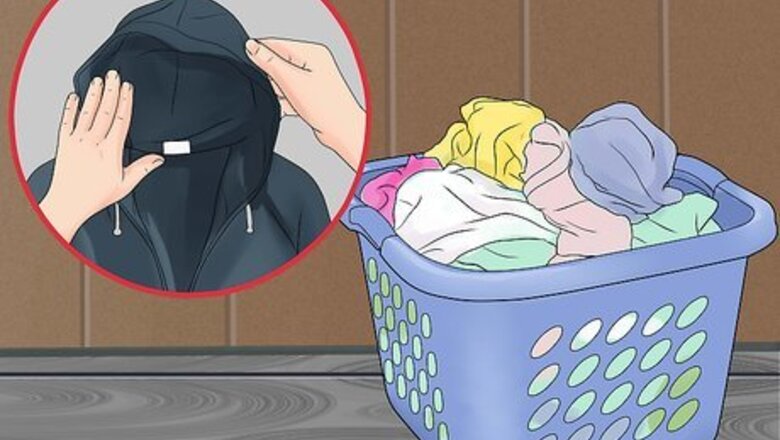
views
Check clothing labels.

Labels can tell you the best way to wash and care for each article. If your laundry is in a giant pile, check items to see if they have any special instructions and read each clothing label’s fabric content (whether it’s polyester, cotton, corduroy, a blend of fabrics, and so on). Since fabric content often determines how an article needs to be washed, it’s important to know beforehand! Read the care instructions on an article of clothing the first time you wash it, and look again during the sorting process on future washes in case you forget. Consider checking each item you’ve sorted as you put it into the washing machine to prevent mishaps.
Sort clothes by color.

Dark items may bleed in the wash and stain lighter clothes. Separating items by color can prevent dye transfer problems during washing that often ruin or damage clothing, especially white or lighter-colored clothing. So, aim to sort your clothing into the following color piles if possible: Light clothing. Include any white clothes, including socks, t-shirts, underwear, and other white cotton items, as well as lighter colors like off-white and tan. Colors. This pile should include brighter colors, including pink, lavender, bright blue, green, and yellow. Dark clothing. The dark pile should have deep grey, black, navy, red, and purple articles of clothing. If you have patterned items (florals, plaids, stripes, and so on), sort them based on the pattern’s main color. Try separating denim into its own pile and washing denim clothes individually or with other dark pieces.
Sort clothes by fabric type.
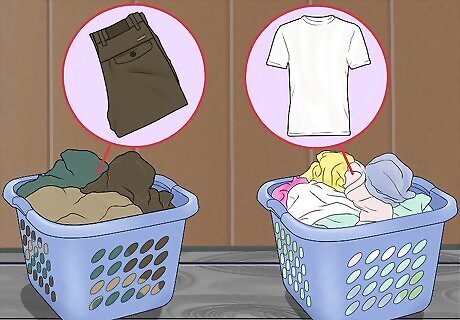
Heavier fabrics should be washed separately from lightweight ones. Sort items made of different fabrics after you’ve put your clothing into color piles. Heavy fabric (like denim, towels, and wool) can be abrasive and damage lighter, fine fabrics (like chiffon, linen, and satin). Sorting clothes this way can also prevent lint from sticking to certain fabrics and speed up the drying process. For example, heavy cotton pants shouldn’t be washed with thin t-shirts since the heavier pants might damage or scratch the shirts. Put any delicates in piles by color. Delicates include lingerie, pantyhose, washable silks, and anything you want to keep from harsh agitation in the washing machine. Separate items that are “lint-givers” from “lint-receivers.” For example, you shouldn’t put towels with corduroy articles. Consider sorting out synthetics and natural fibers if you want to run a separate washing cycle. This can further prevent lint transfer.
Sort blended fabrics.
Group blends according to the fabric with the greatest percentage. When you look at the label for a piece of clothing made with a blend of different fabrics, look for the fabric with the highest concentration and follow the proper washing instructions for that type of fabric. For example, if a shirt has 80% cotton and 20% polyester, wash it like you would any other cotton garment. However, if an article of clothing has any silk (even if it’s just a small percentage), wash it with other silks. The same is true for articles with wool or cashmere. In fact, a garment with wool and silk should be washed with wool garments (prioritizing wool over silk). This is because wool, silk, and cashmere are all very delicate, and regular washing methods might damage them. However, some fabrics are too delicate to be washed (or exposed to water at all) and need to be professionally dry-cleaned, especially if you see a “do not wash” label on the tag.
Separate especially dirty items.
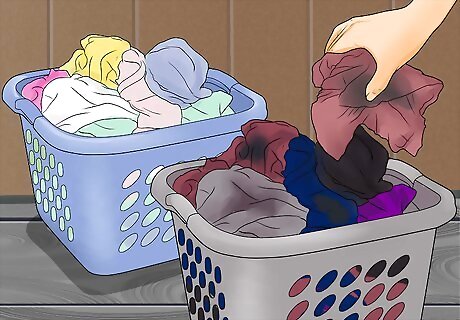
Heavily soiled laundry should be washed longer to avoid stains. If you have clothing that’s very soiled or stained, consider sorting them into a separate pile, as they may need to be pre-treated for stains or washed on a specialty cycle. Specialty cycles may be too harsh for other clothes, so it’s best to wash super dirty clothes separately. This also prevents soils or stains from spreading to other articles of clothing. Pretreat any stains or soils with a stain remover before putting it in the washing machine. Stain remover can make laundry detergent more effective at removing stains and further prevent a stain from transferring elsewhere.
Make sub-categories for your items.
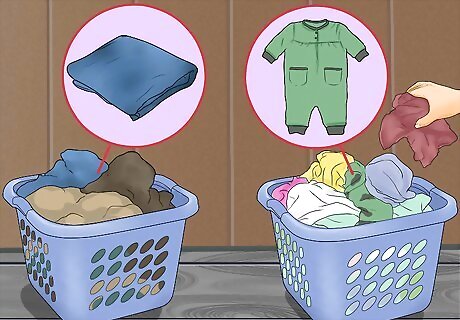
For especially large loads, separate articles by item type. By creating sub-categories based on the type of clothing or article (in addition to separating by color, fabric, and level of dirtiness), you can protect all of your laundry from damage. It’ll also help you choose the right cycle for each sub-category and break down large loads into more manageable amounts. Consider categories such as: Everyday clothing (t-shirts, button-down shirts, underwear, and socks) Denim (pants, shirts, and other items made from denim) Sheets, towels, and bedding Performance fabrics (including activewear like running shorts and swimwear) Wools (including blankets and clothing) Delicate fabrics (including blouses, evening wear, and hosiery)
Wash new clothes on their own.
New clothing tends to bleed dye more than used items. If you have any brand-new pieces of clothing that need to be washed, consider washing them on their own (even if they’d normally fit with another group, like bright colors or bedding). Washing new items separately is the best way to ensure their dyes don’t bleed onto other articles you’re washing. You don’t need to do this forever; after the first few cycles, wash new garments alongside your other items. Bright and darkly-colored items have the potential to bleed into light items even after the first couple of washes, which is why it’s so important to separate laundry by color!
Put delicates in a protective bag.

Mesh laundry bags can prevent tearing and tangling in the wash. If you wash delicates and socks, invest in mesh lingerie bags; in addition to protecting your delicates, they can keep pairs of socks from getting mismatched or lost. Be sure to keep socks and delicates in individual bags since they’re often different colors and fabric weights. Try using zippered pillowcases for delicates and socks if you don’t want to invest in lingerie bags. Pin together pairs of socks as you sort them to keep them together. Buy lingerie bags made of a simple mesh, and ensure the mesh openings don’t let any articles escape while washing.
Invest in a laundry sorter.
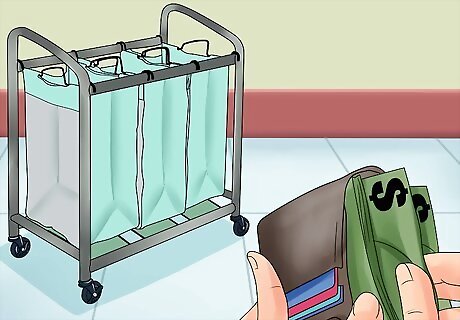
Landry sorters can speed up the process of separating clothes. If you do multiple loads of laundry a week or want to make it easier to separate (and load) different types of laundry, consider getting a laundry sorter—which is a type of hamper with multiple sections, so you can designate each section to hold a different type of laundry. This can make doing laundry a quicker, easier process. Figure out exactly how many laundry categories you want before getting a laundry sorter. For example, you might want a sorter with different sections for whites, lights, and darks. Get a sorter that has as many compartments as you need; you can usually find laundry sorters with anywhere from 2 to 6 sections. Whether or not you have a sorter, try pre-sorting your laundry throughout the week if you plan on doing multiple loads. When it’s time to do laundry, you'll have sorted loads ready! If you only do laundry for yourself (perhaps once per week or less), it may be more efficient to sort all your clothes before washing them.
Make a homemade laundry sorter.
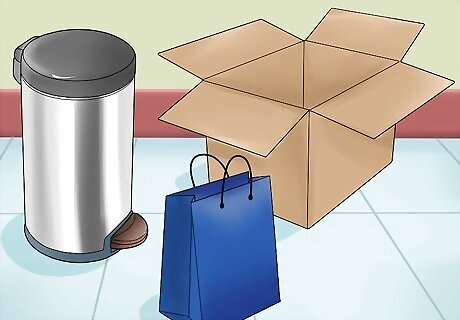
You can save money by making your own laundry-sorting hamper. If you don’t want to spend money on a laundry sorter or divided hamper, fashion one yourself. You can use items around your home—like boxes, shopping bags, or bins—as hampers and keep one handy for each separate load of laundry you plan to wash. Homemade sorters can be just as effective as store-bought products! Alternatively, you could buy individual hampers and set them up together with a separate label for each hamper—or buy different-colored hampers to tell them apart. You might also want to designate a “right away” hamper for items that need immediate attention. If there are multiple people in your household, consider giving each family member a hamper so the person doing laundry doesn’t have to sort through as much clothing. You could also give each family member a color-coded hamper to make sorting clothing even easier. EXPERT TIP Ashley Moon, MA Ashley Moon, MA Professional Organizer Ashley Moon is the Founder and CEO of Creatively Neat, a virtual organizing and life coaching business based in Los Angeles, California. In addition to helping people organize their best life, she has a fabulous team of organizers ready to de-clutter your home or business. Ashley hosts workshops and speaking engagements at various venues and festivals. She has trained with Coach Approach and Heart Core for organizing and business coaching respectively. She has an MA in Human Development and Social Change from Pacific Oaks College. Ashley Moon, MA Ashley Moon, MA Professional Organizer Use helpful tools to deal with laundry. If you dislike wrestling with hangers and tangled piles of clothes, use handy hooks on the wall or door, vented baskets, and modular shelves to neatly file tops and bottoms away post-laundry. Choose the method easiest for you. Also, group items by frequency of use as you go.
Combine loads of laundry when you can.
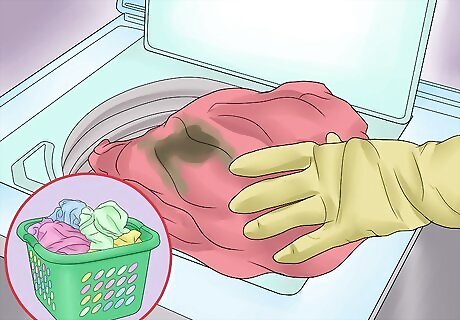
Small loads with compatible fabrics can be washed together. If you have multiple smaller loads of laundry that need to be washed immediately, try combining them into one larger load of laundry. Washing compatible clothing types can reduce the work you have to do and save energy, water, and detergent. Check both loads you want to combine to ensure they’re compatible. For example, delicates and jeans shouldn’t be washed together, but you could wash jeans with dark towels since they’re both heavy fabrics. When in doubt, wash combined loads with cold water, since more delicate fabrics require cold water anyway. Pick out any articles that are different fabrics or have specific laundering requirements. For example, if you have jeans mixed in with dark colors, remove any t-shirts or lighter items from a load of jeans and dark towels.

















Comments
0 comment